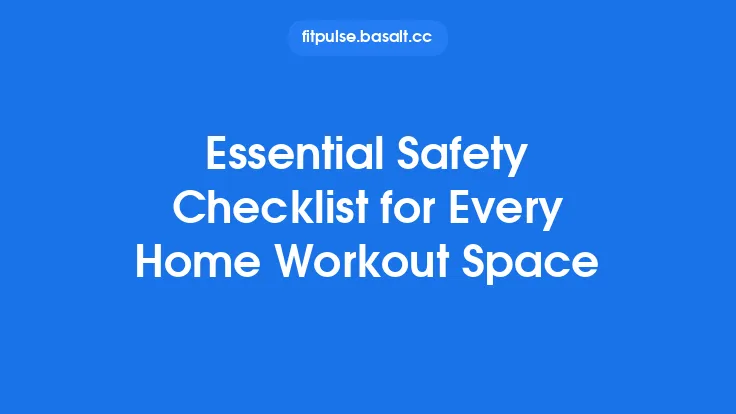When space is at a premium, building an effective home workout routine can feel like a puzzle—how do you get the most out of a square meter without sacrificing variety, safety, or results? The good news is that modern fitness manufacturers have responded to the “tiny‑apartment” market with a wave of compact, purpose‑built tools that deliver high‑intensity training without hogging floor space. Below is a curated list of ten compact pieces of equipment that consistently rank among the most space‑efficient options for home exercisers. Each entry includes key specifications, functional benefits, and practical considerations so you can match the gear to your goals, budget, and living situation.
1. Adjustable Dumbbell Set
What it is
A single pair of dumbbells that can be re‑configured to multiple weight increments (typically 5–50 lb or 2.5–25 kg per hand) by sliding or turning a selector dial.
Why it works in small spaces
- Footprint: Roughly the size of a large hardcover book (≈ 12 × 8 × 3 in).
- Versatility: Replaces an entire rack of fixed‑weight dumbbells, eliminating the need for multiple bars and plates.
- Ease of transition: Weight changes take seconds, keeping workout flow uninterrupted.
Technical note
Most models use a selector‑pin mechanism (e.g., Bowflex) or a dial‑locked plate system (e.g., PowerBlock). The latter tends to be more stable for heavy lifts because the plates lock into a fixed position rather than relying on a spring‑loaded selector.
Pros
- Saves up to 90 % of floor area compared with a traditional rack.
- Ideal for strength, hypertrophy, and functional training.
Cons
- Upper weight limits may not satisfy advanced lifters.
- Slightly higher upfront cost than a single set of fixed dumbbells.
Price range
$150–$350 for a 5–50 lb set; premium models can exceed $500.
2. Fold‑able Bench with Integrated Storage
What it is
A compact, adjustable‑angle bench that folds flat against a wall or under a bed, often featuring a hollow interior for storing small accessories (e.g., plates, bands).
Why it works in small spaces
- Dimensions folded: Typically 4 ft × 2 ft × 4 in.
- Multi‑angle: 0°, 30°, 45°, and 90° positions cover flat presses, incline work, and seated rows.
- Dual‑purpose: When unfolded, it becomes a sturdy platform for step‑ups, Bulgarian split squats, and seated dumbbell work.
Technical note
Look for a bench with a steel frame and a high‑density foam cushion covered in vinyl or leatherette. A weight capacity of 600 lb ensures stability for most users.
Pros
- Eliminates the need for a separate step platform.
- Storage compartment reduces clutter.
Cons
- Folding mechanism can be noisy if not well‑lubricated.
- Requires a small amount of clearance for the backrest to open fully.
Price range
$120–$250 for a quality fold‑able bench.
3. Compact Rowing Machine (Vertical Design)
What it is
A vertical‑rail rowing ergometer that slides up and down a slim frame, often with a quick‑fold feature that reduces the height to a fraction of its full size.
Why it works in small spaces
- Footprint (unfolded): Approximately 2 ft × 2 ft.
- Height when stored: 3–4 ft, fitting under a loft bed or in a closet.
- Full‑body cardio: Engages legs, core, and upper body, delivering a high‑calorie burn in a short time.
Technical note
Magnetic resistance systems provide silent operation and allow precise resistance adjustments via a digital console. Some models incorporate Bluetooth for app integration (e.g., rowing analytics, heart‑rate sync).
Pros
- Low impact on joints, suitable for all fitness levels.
- Provides measurable performance data (stroke rate, power output).
Cons
- Slightly higher price point than a basic bike or stepper.
- Requires a stable floor surface to avoid vibration.
Price range
$300–$700 for reputable brands.
4. Suspension Training Kit
What it is
A set of adjustable straps with handles, foot loops, and anchor points that can be attached to a doorframe, ceiling joist, or sturdy pole.
Why it works in small spaces
- Storage: Can be rolled up into a 12‑inch tube.
- Exercise variety: Enables push‑ups, rows, curls, triceps extensions, core work, and even assisted pull‑ups.
- Scalable resistance: Body weight provides the load, making it adaptable for beginners to advanced athletes.
Technical note
Look for kits with a high‑strength polyester webbing (≥ 500 lb load rating) and reinforced metal carabiners. Some models include a door anchor with a safety lock to prevent accidental opening.
Pros
- No permanent fixtures required.
- Ideal for functional training and mobility work.
Cons
- Requires a solid anchor point; not suitable for flimsy doors.
- Limited to body‑weight resistance; may need supplemental weight for strength progression.
Price range
$50–$150 depending on brand and accessories.
5. Mini Stepper with Resistance Bands
What it is
A low‑profile stepper that mimics stair climbing, often equipped with built‑in resistance bands for upper‑body engagement.
Why it works in small spaces
- Dimensions: Roughly 12 in × 12 in × 6 in.
- Dual‑function: Provides cardio while the bands allow simultaneous arm work (e.g., bicep curls, shoulder presses).
- Quiet operation: Magnetic or hydraulic resistance keeps noise to a minimum.
Technical note
A stepper with adjustable resistance levels (via a dial or magnetic plates) lets you fine‑tune intensity without changing the device’s footprint.
Pros
- Compact enough to fit under a desk for “work‑while‑you‑move” sessions.
- Low impact on knees compared with high‑step aerobics.
Cons
- Limited to lower‑body cardio; not a full‑body strength solution.
- Some users find the motion repetitive after extended use.
Price range
$80–$180.
6. Wall‑Mounted Pull‑Up Bar (Fold‑Away)
What it is
A sturdy bar that mounts to a wall stud and folds flat against the wall when not in use, often featuring multiple grip positions (wide, neutral, chin‑up).
Why it works in small spaces
- Footprint: Only the wall area it occupies (≈ 2 ft × 1 ft) when folded.
- Strength focus: Enables body‑weight pulling movements essential for upper‑body development.
- Durability: Steel construction can support 300 lb+ loads.
Technical note
Installation requires locating a wall stud and using lag bolts for secure anchoring. Some models incorporate a quick‑release latch for effortless folding.
Pros
- No floor space required.
- Adds a functional strength element often missing in compact gyms.
Cons
- Installation is permanent; not ideal for renters without permission.
- Limited to pulling exercises; needs complementary equipment for pushing movements.
Price range
$70–$150.
7. Compact Adjustable Kettlebell
What it is – A single kettlebell that can be dialed to multiple weight settings (commonly 5–40 lb or 2.5–20 kg) by adding or removing internal plates via a quick‑lock mechanism.
Why it works in small spaces
- Size: Roughly the dimensions of a standard 20‑lb kettlebell (≈ 10 in diameter).
- Versatility: Enables swings, goblet squats, Turkish get‑ups, and single‑arm presses without needing a full rack of kettlebells.
- Portability: Easy to move around the house for dynamic circuits.
Technical note
The most reliable designs use a steel inner core with a removable plate system that locks with a twist‑lock or push‑button. Look for a model with a smooth, powder‑coated finish to prevent rust.
Pros
- Saves space and money compared with buying multiple kettlebells.
- Quick weight changes keep high‑intensity interval training (HIIT) flowing.
Cons
- Upper weight caps may limit progression for advanced users.
- Slightly heavier than a fixed kettlebell of the same weight due to the internal mechanism.
Price range
$120–$250.
8. Fold‑able Yoga / Pilates Mat with Integrated Foam Roller
What it is – A dual‑purpose mat that folds in half, revealing a built‑in foam roller on the underside. When unfolded, it serves as a standard 1/4‑in thick exercise mat.
Why it works in small spaces
- Storage: Takes up the same footprint as a regular mat (≈ 68 in × 24 in) but adds a rolling component without extra bulk.
- Functionality: Perfect for mobility work, core activation, and post‑workout stretching.
- Portability: Light enough to slide under a couch or store in a closet.
Technical note
High‑density EVA foam provides a stable surface for balance work while the roller side uses a firmer, textured foam for myofascial release.
Pros
- Eliminates the need for a separate roller, saving space and cost.
- Encourages a holistic approach (strength + mobility).
Cons
- The roller side may be less firm than a dedicated high‑density roller.
- Slightly thicker than a standard mat, which could affect balance drills for some users.
Price range
$40–$80.
9. Compact Air‑Powered Resistance Trainer (e.g., AirFit)
What it is – A lightweight, inflatable resistance device that uses air pressure to provide adjustable resistance for upper‑body and lower‑body exercises.
Why it works in small spaces
- Deflated size: Fits into a small drawer (≈ 6 in × 4 in × 2 in).
- Inflated footprint: Expands to a 2‑ft‑wide, 1‑ft‑tall cylinder, still far smaller than a traditional weight stack.
- Adjustable resistance: Change the pressure via a hand pump to increase or decrease load.
Technical note
The device typically includes a built‑in pump and a pressure gauge. Resistance levels can range from 5 lb to 150 lb, making it suitable for both rehab and strength work.
Pros
- No metal plates, so it’s safe for apartments with noise restrictions.
- Easy to store and transport.
Cons
- Requires periodic re‑inflation as air leaks slowly over time.
- Not ideal for maximal strength training (e.g., heavy deadlifts).
Price range
$70–$130.
10. Multi‑Function Mini Cable System
What it is – A wall‑mounted, low‑profile pulley system that uses a short cable and interchangeable handles to deliver resistance for rows, triceps push‑downs, chest flyes, and more.
Why it works in small spaces
- Mounting footprint: Occupies a 12 in × 12 in area on the wall.
- Adjustable resistance: Uses a weight stack (typically 5–50 lb) or a resistance band sleeve for a quieter, lighter setup.
- Full‑body capability: Provides pulling and pushing motions without needing separate machines.
Technical note
Look for a system with a steel cable (minimum 1/8‑in diameter) and a low‑friction pulley bearing. Some models incorporate a quick‑release latch for easy handle changes.
Pros
- Adds a true cable‑pull experience in a compact format.
- Allows progressive overload with a small weight stack.
Cons
- Requires a sturdy wall anchor; not suitable for drywall without reinforcement.
- Limited maximum resistance compared with full‑size cable towers.
Price range
$150–$300.
Putting It All Together
When curating a compact home gym, the goal is to maximize functional variety while minimizing the physical and visual footprint. The ten pieces listed above each address a distinct training modality—strength, cardio, mobility, and functional movement—without overlapping the storage‑oriented topics covered in neighboring articles. By selecting a combination that aligns with your personal fitness objectives (e.g., strength + cardio, or strength + mobility), you can assemble a well‑rounded workout station that fits comfortably in a bedroom, living‑room corner, or even a hallway closet.
Tips for a Cohesive Setup
- Prioritize multi‑functionality – Choose equipment that offers several exercise options (e.g., a fold‑able bench with storage, a suspension kit).
- Layer vertically – While this article avoids detailed storage solutions, simply hanging the pull‑up bar and mini cable system on the same wall frees floor space.
- Maintain a clear workout zone – Keep a 3‑ft radius around the equipment free of furniture to ensure safe movement, especially for dynamic tools like the rowing machine or stepper.
- Invest in quality – Compact gear often bears higher engineering demands; a sturdy frame and reliable locking mechanisms will extend the lifespan and keep the equipment safe for daily use.
- Rotate equipment seasonally – If you have a very tight space, consider swapping out a piece (e.g., mini stepper for the air‑powered trainer) based on your training focus for the month.
By integrating these space‑saving powerhouses, you’ll have a versatile, effective home workout environment that feels far larger than the square footage it occupies. Happy training!





